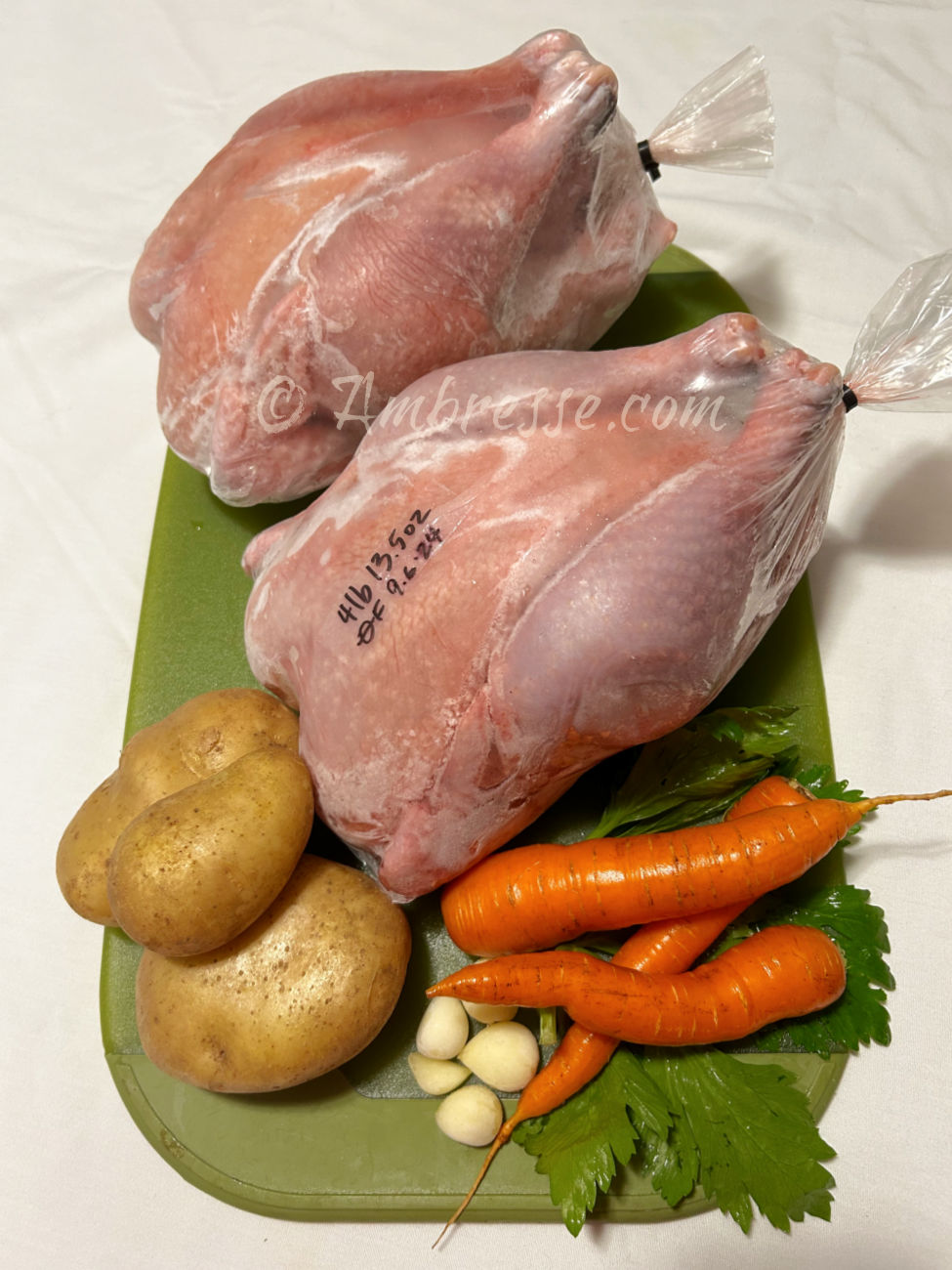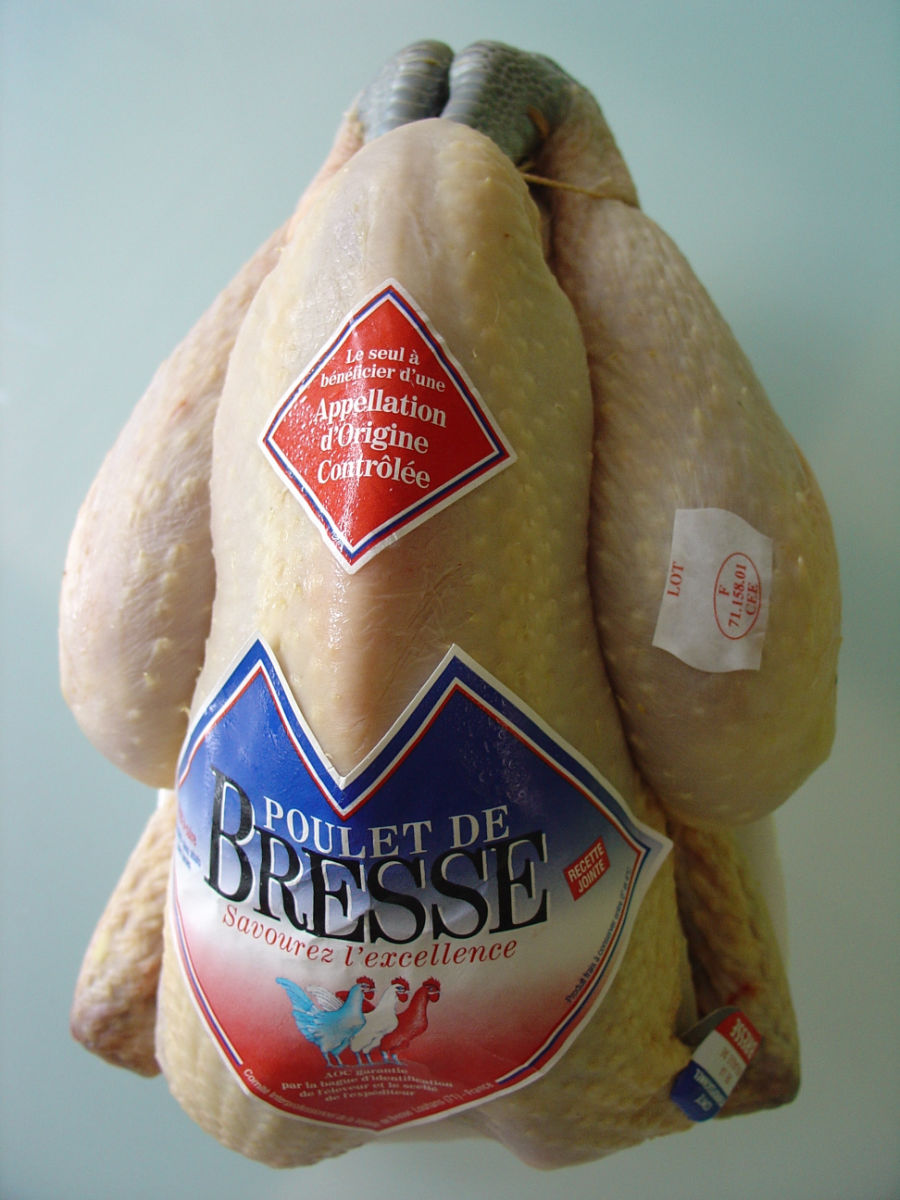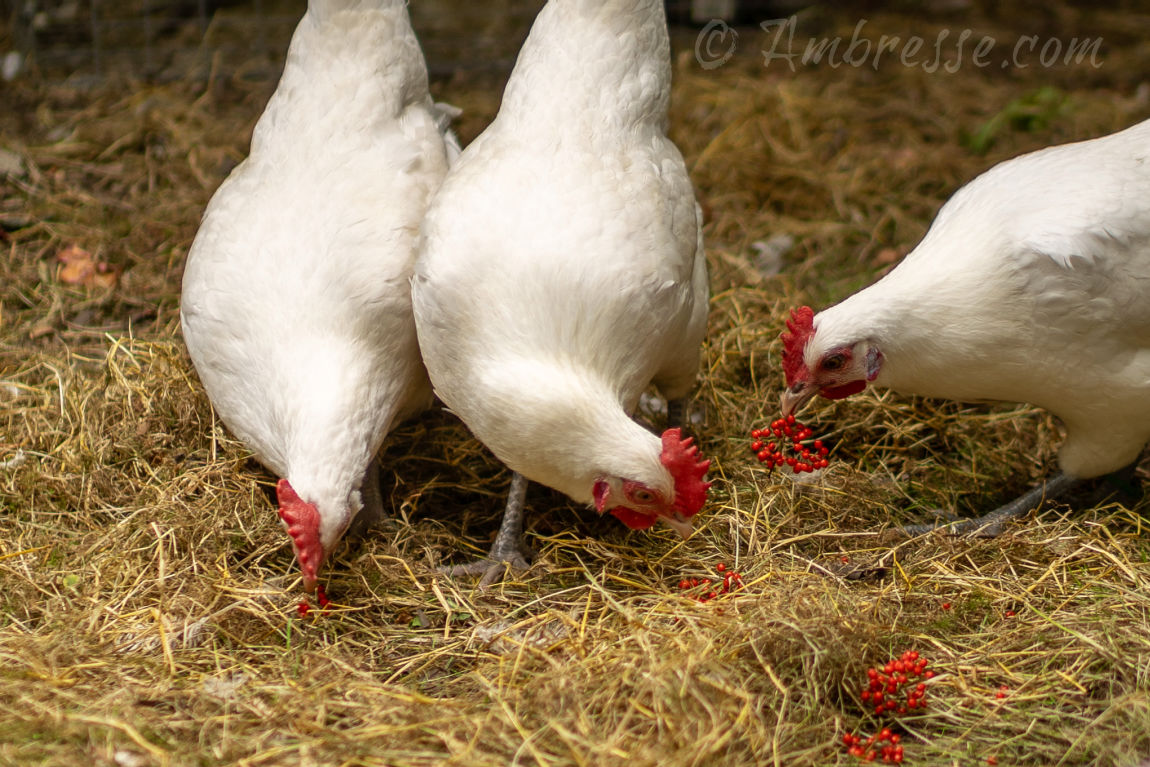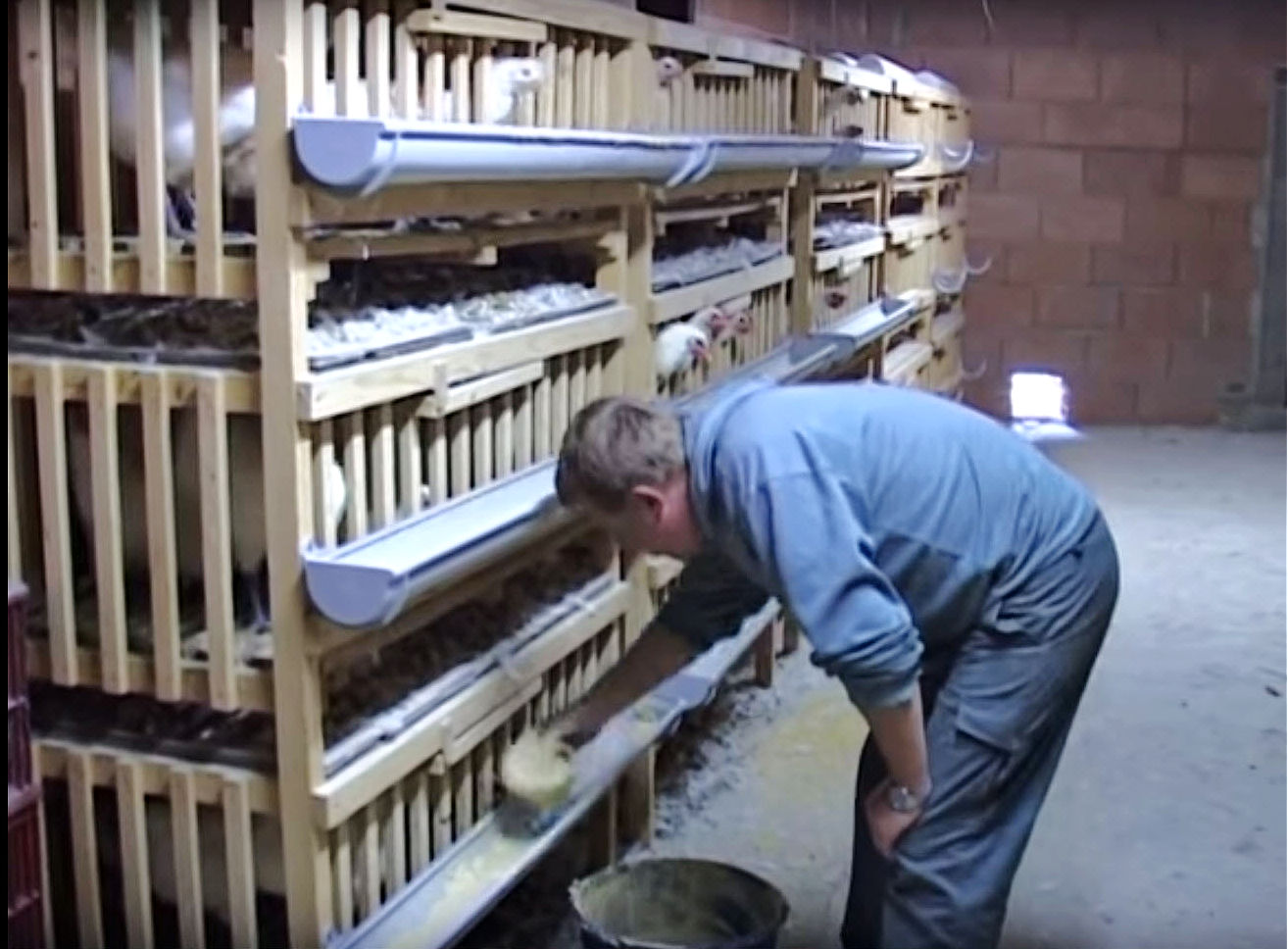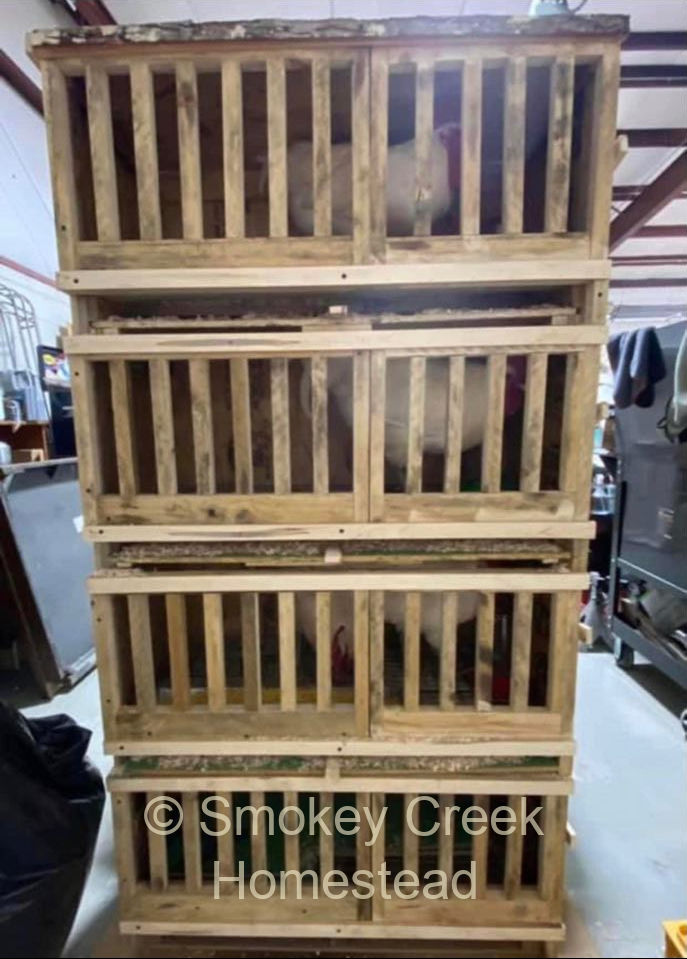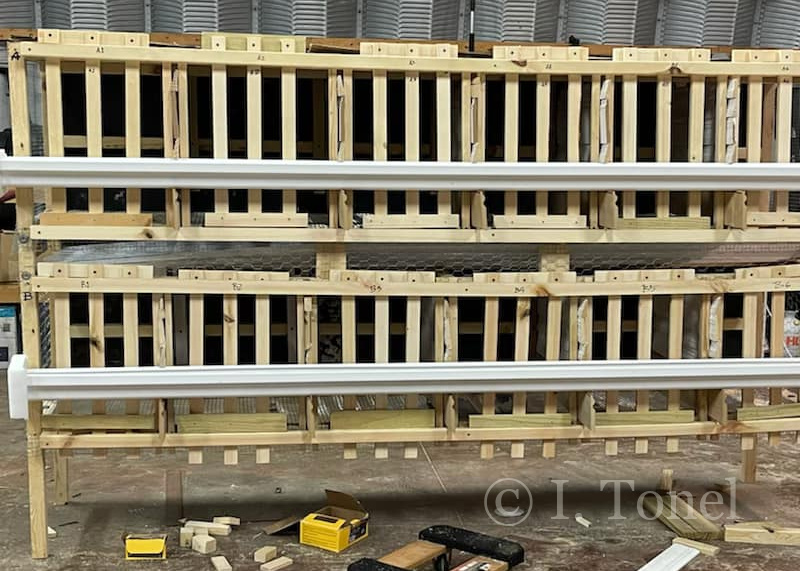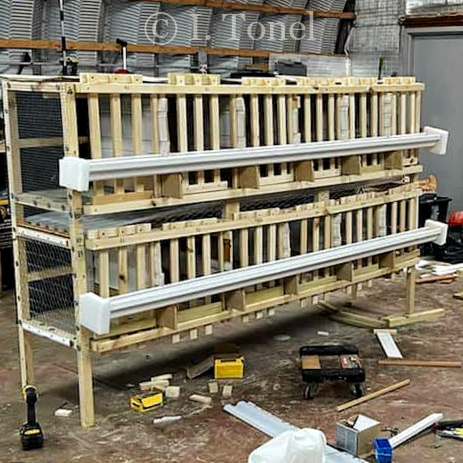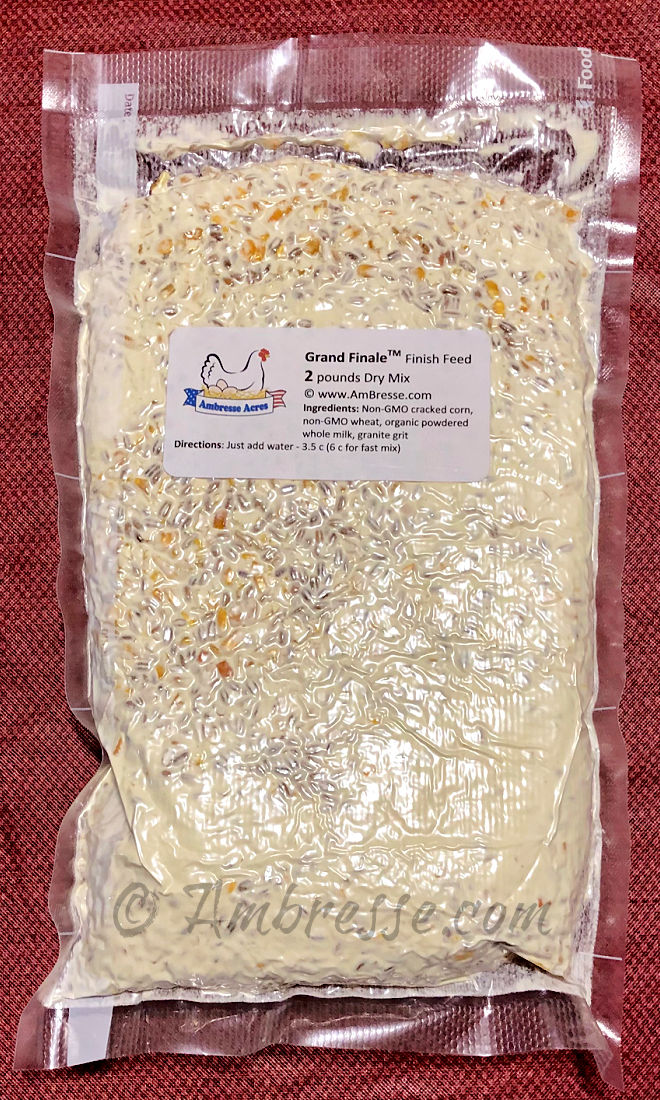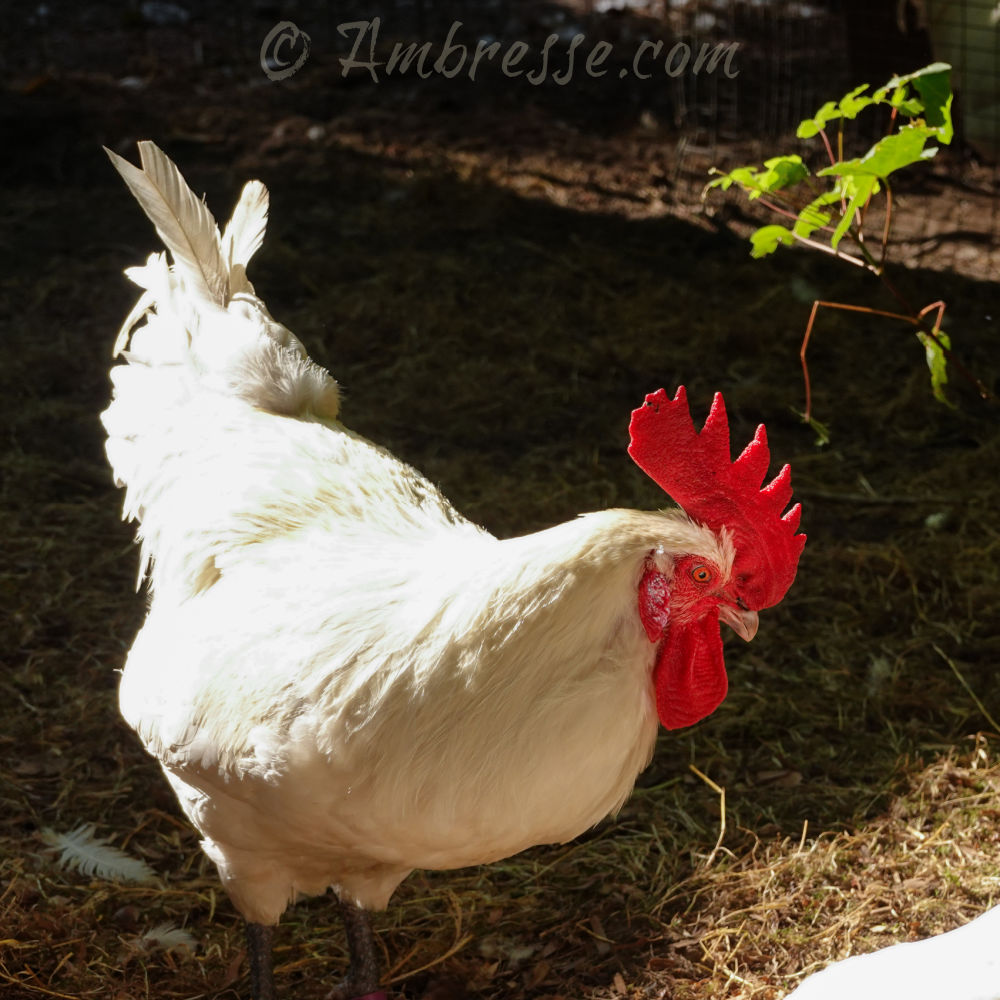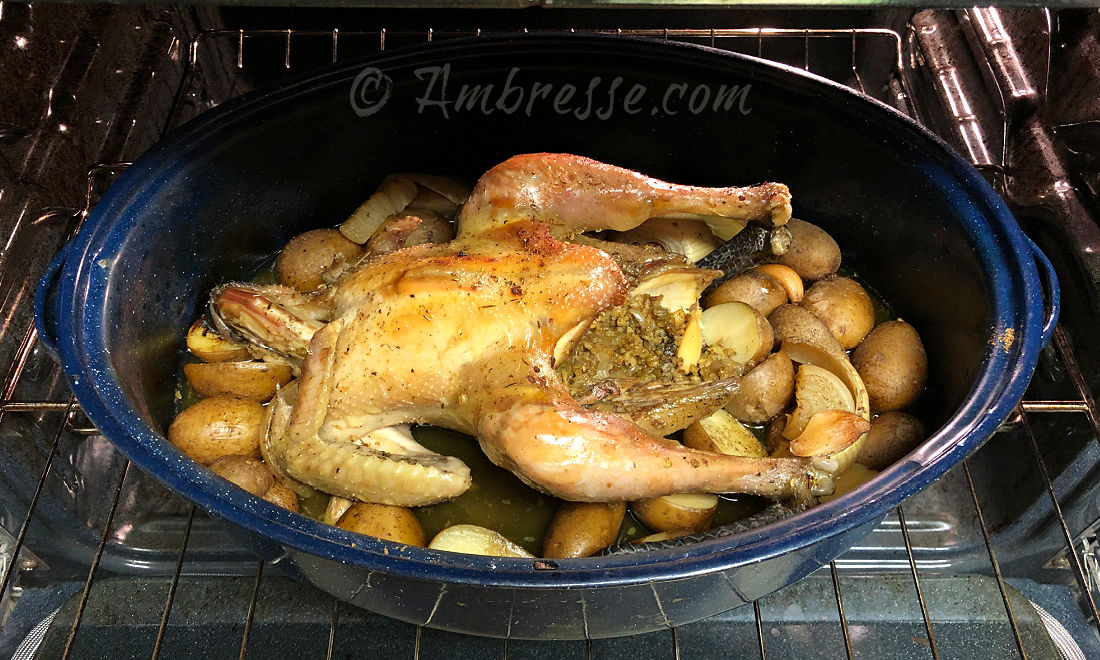Finishing American Bresse Chickens
Finishing American Bresse Chickens: What is finishing, how to finish American Bresse, plus options for finishing in prep for processing, including feeding, housing, and lighting.
Many homesteaders have been used to raising Cornish Cross meat chickens for the dinner table.
Cornish Cross meat birds are a 4-way terminal cross hybrid, meaning you cannot just breed and raise them. You must purchase chicks every time you wish to raise and process meat birds for the table. CC grow extremely rapidly and are typically processed at age 6-8 weeks. There is no time and no need to do anything extra in order to "finish" these birds. Nor do they have near the flavor when compared to an American Bresse bird finished and processed at 14-16 weeks.
With the advent of the American Bresse as an ideal dual purpose breed (you might even say triple purpose if you count the rich flavor and fat marbling along with the meat and eggs), you can now raise your own meat birds at home sustainably, generation after generation.
What is "Finishing?"
Finishing is the term commonly used to describe the entire process of turning meat chickens into market chickens, whether they actually go to market, or whether they end up in your own freezer or on your dinner table.
The KEY to finishing is the presence of the genetic gene that enables fat marbling - the transport of fat molecules into the spaces around the muscle groups.
In chickens that lack this gene, finishing will pack on fat in growing fat pads, especially around the tail area. Chickens with the "marbling" gene will add extra fat throughout all the muscle groups, similar to, but not exactly like wagyu beef. The fat adds melt-in-your-mouth moisture and flavor, without detracting from overall human health.
It is called finishing, because when you're done with the process, the birds are indeed "finished" - ready to be processed to serve their designed function: go to the freezer, the dinner table, or the marketplace.
Finishing American Bresse chickens is recommended but not required in order to thoroughly enjoy the breed's excellent flavor.
Overview of the Process of Finishing American Bresse
Starting as 8-week-old chicks, the meat birds are allowed to forage in the pasture every day. They spend nearly all of their life foraging for bugs and greens. This is a lot of daily activity that builds a strong muscular structure, and the extra nutrients from the field provide enhanced nutrition and flavor, contributing to finishing's end result.
Current societal norms vilify fats even as North Americans get fatter and fatter.
In actuality, the problem is not the fat but the huge amounts of processed sugar in American diets.
Eating a moderate amount of fats helps to moderate the effects of excess sugar (glycemic index reduction) in a meal.
So, marble away!
The process of finishing American Bresse may take from 8 days to several weeks. It includes:
- Feed grains soaked in milk: Milk products are a well-known source of overall nutrition and fat calories. Corn contributes carbs and wheat balances the nutritional intake. This grain/milk mash will be the bird's sole food source for the duration of the finishing process.
Regular feed may offer 5% fat, while finishing rations are typically 8% fat. - Confinement: Confinement limits the level of activity so that the fat and carb calories provided by eating ad libitum (as much as they want) will turn into fat.
- Darkened Space: Providing a dark space for the epinettes (cages) helps to further minimize the bird's need to move about, while contributing to environmental peace and quietness.
French Bresse Finishing is the Model for Finishing American Bresse
The American Bresse finishing process roughly mimics French Bresse finishing practices. In France, French Bresse farmers must carefully follow a specifically prescribed finishing protocol in order to sell their chicken with the label: "Poulet de Bresse" (Chicken from Bresse).
Since the French have been at this for hundreds of years, why re-invent the wheel? American Bresse farmers that finish their birds the French way are finding excellent success.
Nevertheless, many ABC breeders still feel comfortable making as many tweaks to the French Bresse finishing process as they desire.
- Almost every breeder uses some form of dairy product, but amounts and percentages may vary.
- Nearly every breeder uses corn, whether soaked in milk or not.
- Nearly every breeder adds some additional type of grain, but some do not.
- Many breeders confine their birds to some extent, whether in a darkened building, cage, or epinette, but other breeders do not.
Whether breeders stick religiously to their personal interpretation of the French finishing methods, or whether they tweak the process till they're happy as clams, the vast majority of American Bresse farmers still seem to rave over the exquisite flavors of their chicken dinners.
Click here for more details about how French Bresse market birds are finished.
In the future it could be that the American Bresse Breed Club will find it useful to create a recommended finishing process for American Bresse chickens, whether identical to, or slightly divergent from the French processes. But in the meantime, finished American Bresse birds are already making farmers and customers very happy.
When to Start Finishing American Bresse
The starting age for finishing American Bresse meat birds, and the duration of finishing, varies with the product AND with the preferences of each individual ABC breeder. In North America:
- Finishing for pullets starts at 14-18 weeks of age for processing at approximately age 20-21 weeks.
- Finishing for capons starts at a much older age: 8 months of age for processing at 9 months.
Bresse cockerels are usually caponized in France. This is because the actions of testosterone in the cock's body naturally counteract the finishing results. Click here for details on testosterone and finishing cockerels. - In North America, finishing for cockerels starts at 11-14 weeks of age for processing at 14-16 weeks. Cockerels raised and finished nearly to the point of maturity (20-21 weeks) DO gain fat, sometimes more than a pound of it. The processed carcass may weigh an average of 5 pounds.
- Sixteen weeks is a common theme for age of processing, but is by no means a hard and fast rule. Processing preferences tend to range between 14 weeks and 24 weeks. Many breeders love the taste of birds processed at 18 weeks or older, because the older birds have more fat and flavor in the breeders' estimation.
Note that birds processed much beyond 17 or 18 weeks of age may need to be cooked "low and slow" to ensure tenderness, whether finished or not.
Finishing American Bresse Chickens:
How-To Directions
Before Finishing: Introduce chicks to pasture foraging at 5 - 8 weeks of age so they can supplement their 20 - 22% chick feed with bugs and greens until the finishing process starts.
The finishing process: It's not complicated at all. Confine the meat birds in a darkened space, feed them an unending diet of milk-soaked grain mash for a predetermined period of time, and then process.
- Start age: The finishing process begins when the meat birds are approximately 12-14 weeks of age. See the When to Start Finishing section above.
- Caging: Move the meat birds into cages. An epinette is a wooden cage constructed of spruce wood used in France. See Epinettes below. I personally use wire cages with ample room to stretch and move. Capons and pullets can be housed together, but cockerels, unless extremely docile, will require separate cages to prevent fighting. Ideally, cages are housed in a darkened space.
- Feed: Milk-soaked corn/grain mash. See additional details below.
- Finishing Timeline: The finishing process lasts 1-4 weeks, depending on product and preferences. A few breeders like to take up to 6 weeks for the finish. Finishing at Ambresse Acres usually lasts 2 weeks. Typical age at processing depends on the product. See When to Start Finishing section above.
The Confinement Cage, also Called an Epinette
In France, finishing market birds are placed in cages known as epinettes. (Epinette in French means "spruce.") These are wooden cages made of spruce wood with slatted fronts and tops. There is plenty of room for the birds to stretch, and the slats allow easy access to feed troughs laden with milk-soaked grains.
Get Epinette Building Plans!
Epinette for Chickens - Get beautiful PLANS for building French-style wooden-slatted finishing cages with troughs for finishing feed in front of the epinettes. These Epinette Plans were produced through collaboration with Leslee Wooton, who has been breeding and finishing American Bresse chickens since 2011 at Eldervine Farms in North Carolina.
(Photo is a screen grab from https://www.youtube.com/watch?v=iKj8vj8rFHo)
Epinettes are usually housed in dark barns. Dim lighting reduces activity and supports the process of fat marbling.
Pullets and capons can be housed together in the same epinette, but cockerels have a proclivity of getting testy with each other. Dominant cockerels may pick fights and wound (or kill) other cockerels in the cage.
Pictured at right is a homemade wooden finishing cage, or epinette, at Smokey Creek Homestead in North Carolina (used with permission). Its dimensions are approximately:
- 4 feet wide (or wider)
- 2 feet deep
- Stacked 4 units high
- Slats are 1" x 2" (standard lumber) with 3" between them
Below: another design for a set of homemade epinettes, designed and built by Irene B. Tonel, in the Philippines. Photos used with permission.
Take a look at the epinettes used by the French in the Youtube video below. This is a 9 minute video showing the entire process of raising French Bresse chickens, from chick to dinner table. The section on epinettes starts at minute 3.03.
Are Epinettes Essential?
Not necessarily. You CAN skip the caging, of course, if you don't mind sacrificing some of the fat marbling that the epinette encourages.
Another housing option might be to keep the birds in a smaller paddock or pasture while feeding the finishing ration and water. The birds will surely gain weight, even if not as much as in cages.
Feeding for the Finish - a Hedonist Holiday
The finishing process includes a hedonist holiday for your birds, where they skip the gym and eat to their heart's content. Before they go to that big Barn-in-the-Sky, your meat birds get one last week or two of an all-you-can-eat, creamy-milky buffet.
Make a Milk-Soaked Mash for Finishing American Bresse
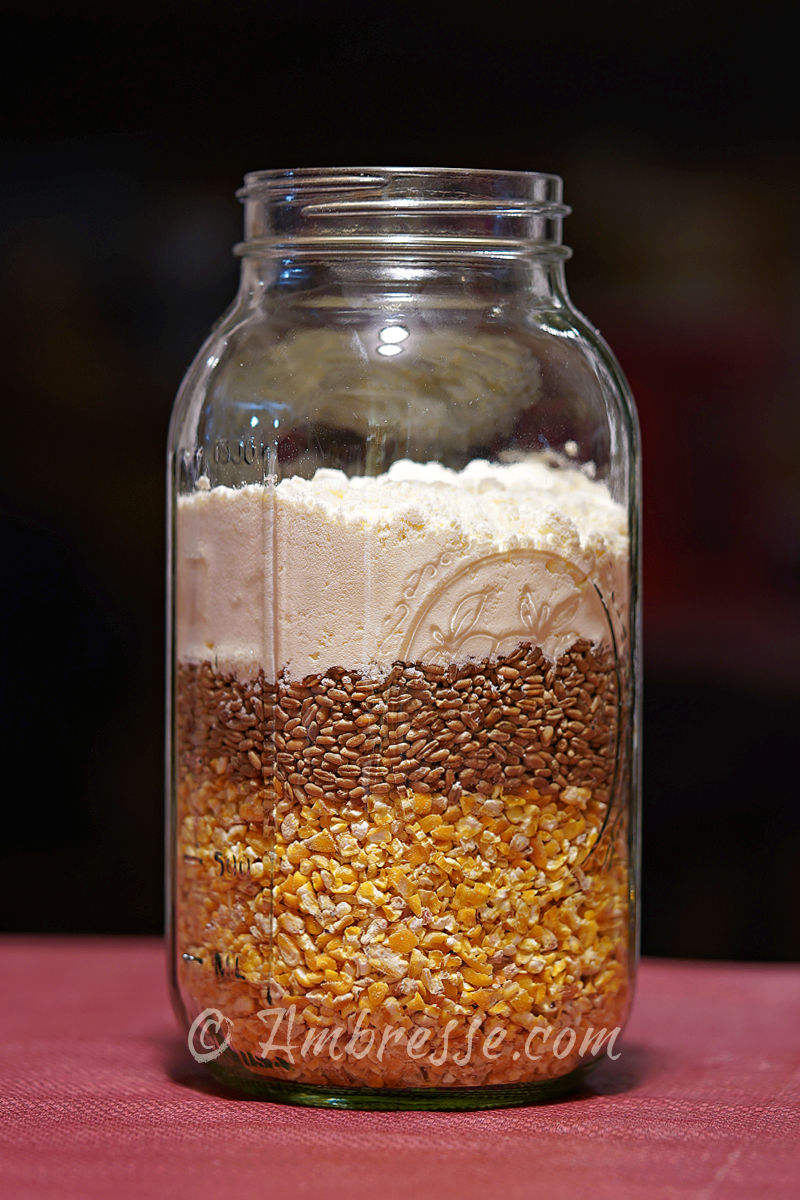
Finish feed is a wet mash combo of grains, usually corn and wheat, that have been soaked in milk. Ambresse Acres has created an effective recipe that mimics French finishing. We soak our grains in reconstituted powdered whole milk, which is very creamy. This becomes the sole feed ration until processing. Check out our Grand Finale Feed Recipe!
Always provide full access to fresh water.
Prepare and Feed the Wet Grain Mash
Preparing the finishing porridge is quite easy:
- In a bowl or bucket, mix well the milk and whatever grains you have chosen to use. (We use cracked corn and hard red wheat kernels.)
- Soak for 12 hours, or overnight.
- Feed the chickens!
Feed the quantity that the chickens will clean up in 12-24 hours. Refill feed trough as needed. They should have this ration in front of them at all times. It will be their only feed for the entirety of the finishing period, which is short - only one week or so for young cockerels, to 4 weeks for capons.
Give your American Bresse Chickens a
Grand FinaleTM!

Ambresse Acres has created a Finish Feed Recipe for our American Bresse meat poultry. It is very effective!
Or If You Prefer....
We can make the Grand Finale Feed for you. It comes in 2-pound vacuum-sealed packages. Oh so convenient to keep a few of these on hand when it comes time to finish the current batch of cockerels.
In just a week at Ambresse Acres, Grand Finale Feed turns our young cockerels into juicy, fat-marbled gourmet poultry.
We are confident you'll find good results as well!
Check out Grand Finale Finish Feed!
Milk Options
Options for Milk: Anything 'dairy,' almost...
- Whole milk, whether cow, goat, or sheep, raw or pasteurized
- Clabbered milk
- Buttermilk
- Whey remaining after cheese production
- Goat cheese
- Powdered whole milk
- If low-fat milk is the only powdered milk available, add a bit of olive oil or melted lard or tallow to the mash
- Lamb milk replacer powder (goat-milk-based) is high in fat
- Calf Milk Replacement Powder (may be pricy as compared to whole milk)
Any milk by-product can be used. Mix and match as needed.
On Processing Day
- Before processing American Bresse: Remove food and water from birds for last 12 hours before processing. This empties the crop and simplifies processing.
- Optional post-processing step: Wrap the carcass tightly in linen or muslin. Wrapping carcasses is nearly unknown in North America, but in France, it is an important step which helps distribute the fat into the tissues, and pulls excess moisture out of the skin for a crispier result when cooking.
- After processing: Chicken meat needs 2-4 days of air cooling and resting in the fridge before cooking or freezing. This is to allow the muscle fibers to fully relax, which will result in tender meat with excellent texture.
Results of Finishing American Bresse Chickens
The good folks at Pacific Northwest Homestead have documented their process of raising American Bresse chickens from chicks, to finishing, to processing. It is quite informative. Click the link to see how they raised, finished, and processed their American Bresse meat chickens.
Once one cooks and serves a finished American Bresse Chicken, it is highly likely that one will soon want to enjoy another finished American Bresse Chicken.
Testimonials from the American Bresse Facebook group:
- "Considering the amount of corn and fatty lamb replacer they were eating I would have expected lots of fat at the vent and around the gizzard. Instead the meat was rippled with fat internally - moist and amazing. (J. Croot)
- "Flavor comes from grass/bugs/age; special finishing is for fat. Their fat melts like butter and it's amazing.... It's been so long since I have had store bought chicken...I remember relying heavily on flavoring to make it decent to eat. Now, I'll eat smoked chicken with no sauce. Only a little salt, pepper and thyme for roast chicken and potatoes, more for the potatoes than the chicken." (M. Royal)
- "Finishing makes life-changing broilers!" (I. Stevens)
Got More Questions about Finishing American Bresse??
- If yes, then check out our American Bresse Finishing FAQ page.
- More answers regarding fat: Is Fat Bad for You?
- Questions about feeding chickens corn, and grain-finishing: Grain-Finishing.
- Grand Finale Finish Feed Recipe can be found here.
- Learn more about Grand Finale Finish Feed here. This is also the purchase page.
- Home
- American Bresse Chickens
- Finishing American Bresse Chickens
What Am. Bresse Finishing Practices Work for You?
---Do you use a particular finishing feed?
---Do you confine your birds, for example, in a finishing space or in epinettes?
---How long do you prefer to finish your birds?
---At what age do you like to process your birds?
---Do you wrap your poultry after processing?
Please share it all with us and with others! You can do so below.
Be as wordy and as descriptive as you like. Include up to four photos as well, if you have them; there is plenty of room for it all on the Ambresse website.
Just click into the title box below and go from there. And thank you in advance for sharing!
References
- https://pubmed.ncbi.nlm.nih.gov/22495883/ - Impact of testosterone on body fat composition
- https://www.backyardchickens.com/threads/french-standards-for-raising-bresse-meat-chickens.866299/
- https://www.youtube.com/watch?v=iKj8vj8rFHo - French Bresse, from chick to processing, including epinettes.
- https://www.pacificnorthwesthomestead.com/blog/processing-my-first-american-bresse
Overheard...
Tasty Recipe! "I processed my first batch of Bresse... Today I roasted one according (somewhat) to the recipe posted on Ambresse. It was delicious! Tender, moist and succulent... So happy I chose this breed!" (B.E., MN, 12/11/2024).
Success: "I can't believe all the inquiries we get through your website. And it's been a great resource to send people to who are interested in the (AB) breed" (Utangard Farm, NH, 5/5/2025).
Informational: "Your site has the first accurate information about American Bresse chickens that I have seen in English. Thanks for your diligent work" (L. Wooton, NC, 12/17/2024).
Translate This Page
Traduire Cette Page
Traduzca Esta Pagina

News
American Bresse Breed Club web pages can be found under the Breed Club tab on the navigation bar. Any changes in Club status will be posted here!
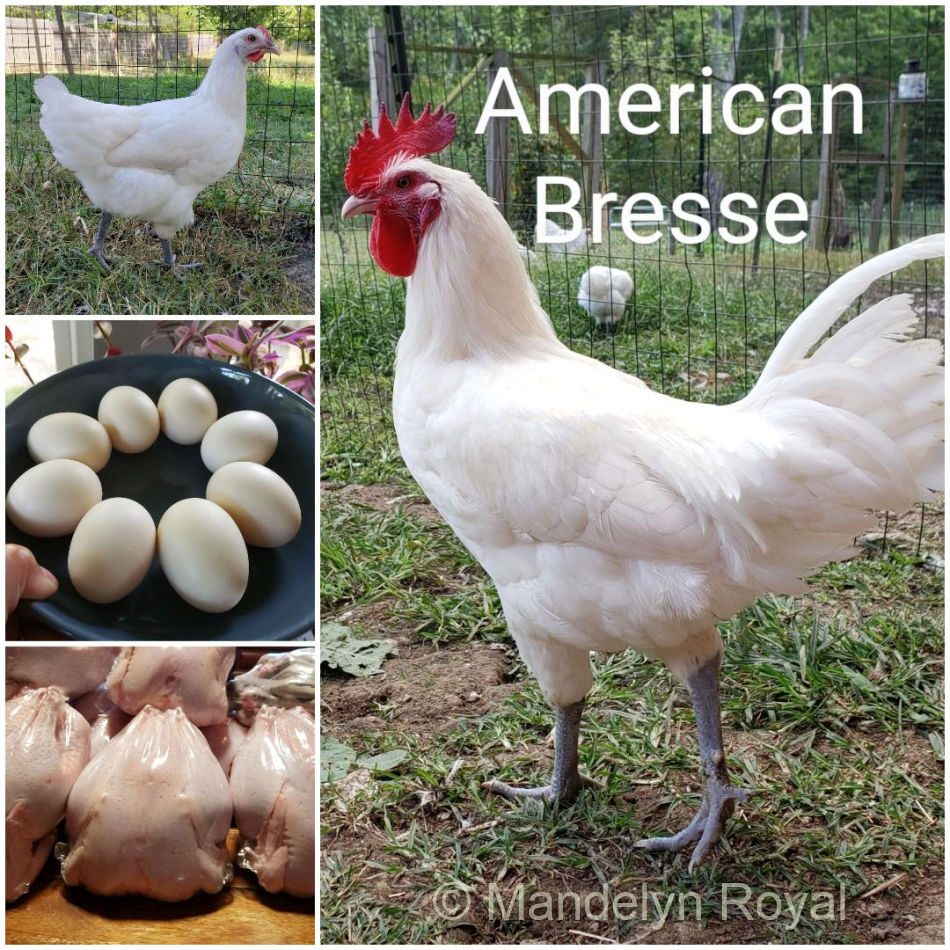
Photo credit: Mandelyn Royal.
